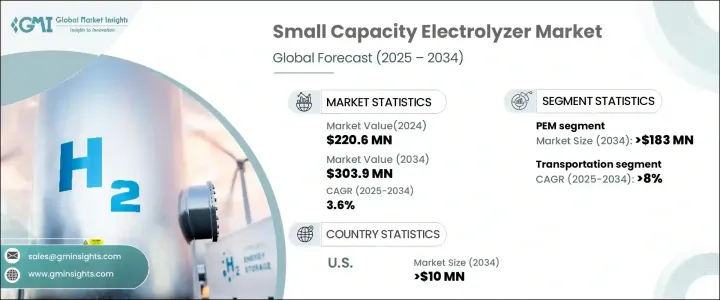PUBLISHER: Global Market Insights Inc. | PRODUCT CODE: 1685216

PUBLISHER: Global Market Insights Inc. | PRODUCT CODE: 1685216
Small Capacity Electrolyzer Market Opportunity, Growth Drivers, Industry Trend Analysis, and Forecast 2025 - 2034
The Global Small Capacity Electrolyzer Market, valued at USD 220.6 million in 2024, is on track to experience steady growth with a projected CAGR of 3.6% from 2025 to 2034. These compact hydrogen generation systems, utilizing water electrolysis, are becoming essential for various localized applications, including research, small-scale industrial processes, residential hydrogen production, and fueling hydrogen-powered equipment. Their ability to generate hydrogen on-site without dependence on centralized infrastructure is a key driver of adoption. As the transition to clean energy accelerates worldwide, small capacity electrolyzers are emerging as a viable solution for decentralized hydrogen production.

The increasing focus on energy independence, sustainability, and the development of efficient hydrogen ecosystems is fueling demand across industries. Government incentives and policies promoting clean hydrogen initiatives are further boosting market expansion. Additionally, advancements in technology and manufacturing processes are reducing production and operational costs, making these electrolyzers more accessible. The ability to scale and integrate seamlessly into different setups enhances their appeal, particularly for industries and regions aiming to achieve carbon neutrality. Companies investing in hydrogen-based energy solutions are leveraging small capacity electrolyzers to enhance efficiency and reduce reliance on fossil fuels, driving long-term growth in this segment.
| Market Scope | |
|---|---|
| Start Year | 2024 |
| Forecast Year | 2025-2034 |
| Start Value | $220.6 Million |
| Forecast Value | $303.9 Million |
| CAGR | 3.6% |
By product type, the Proton Exchange Membrane (PEM) segment is poised to generate USD 183 million by 2034. The rising preference for PEM electrolyzers stems from their high current density, compact structure, and rapid response to voltage fluctuations. Their ability to minimize energy transmission losses and operate efficiently in off-grid locations makes them particularly advantageous for rural and remote areas. Continuous innovations in membrane materials and catalysts are improving the durability and cost-effectiveness of PEM technology, reinforcing its market potential and positioning it as a key driver of growth in the hydrogen economy.
In terms of application, the transportation segment is expected to grow at a robust CAGR of 8% through 2034. The increasing adoption of hydrogen-powered mobility solutions is propelling demand for small capacity electrolyzers, particularly in the development of fueling infrastructure. Strengthening hydrogen supply chains and fostering international trade partnerships are playing a crucial role in the expansion of this segment. As global efforts intensify to reduce carbon emissions and transition to sustainable energy sources, decentralized hydrogen production is gaining traction, further cementing electrolyzers' role in the future of transportation networks.
The U.S. small capacity electrolyzer market is projected to generate USD 10 million by 2034, driven by rising investments in localized hydrogen production. With businesses and policymakers prioritizing energy resilience and emissions reduction, the market is witnessing a surge in adoption. The growing number of renewable energy projects, coupled with corporate initiatives to integrate clean energy solutions, is further accelerating demand. Industries looking to meet sustainability targets are turning to small capacity electrolyzers for efficient on-site hydrogen generation, solidifying their role as a critical component in the transition to a low-carbon economy.
Table of Contents
Chapter 1 Methodology & Scope
- 1.1 Market definitions
- 1.2 Base estimates & calculations
- 1.3 Forecast calculation
- 1.4 Primary research & validation
- 1.4.1 Primary sources
- 1.4.2 Data mining sources
- 1.5 Market Definitions
Chapter 2 Executive Summary
- 2.1 Industry synopsis, 2021 – 2034
Chapter 3 Industry Insights
- 3.1 Industry ecosystem
- 3.2 Regulatory landscape
- 3.3 Industry impact forces
- 3.3.1 Growth drivers
- 3.3.2 Industry pitfalls & challenges
- 3.4 Growth potential analysis
- 3.5 Porter's analysis
- 3.5.1 Bargaining power of suppliers
- 3.5.2 Bargaining power of buyers
- 3.5.3 Threat of new entrants
- 3.5.4 Threat of substitutes
- 3.6 PESTEL analysis
Chapter 4 Competitive landscape, 2024
- 4.1 Introduction
- 4.2 Strategic dashboard
- 4.3 Innovation & sustainability landscape
Chapter 5 Market Size and Forecast, By Product, 2021 – 2034 (USD Million & kW)
- 5.1 Key trends
- 5.2 Alkaline
- 5.3 PEM
- 5.4 Solid oxide
- 5.5 Others
Chapter 6 Market Size and Forecast, By Capacity, 2021 – 2034 (USD Million & kW)
- 6.1 Key trends
- 6.2 ≤ 100 kW
- 6.3 > 100 kW - 300 kW
- 6.4 > 300 kW - 500 kW
Chapter 7 Market Size and Forecast, By Application, 2021 – 2034 (USD Million & kW)
- 7.1 Key trends
- 7.2 Power generation
- 7.3 Transportation
- 7.4 Industry energy
- 7.5 Industry feedstock
- 7.6 Others
Chapter 8 Market Size and Forecast, By Region, 2021 – 2034 (USD Million & kW)
- 8.1 Key trends
- 8.2 North America
- 8.2.1 U.S.
- 8.2.2 Canada
- 8.3 Europe
- 8.3.1 Germany
- 8.3.2 UK
- 8.3.3 France
- 8.3.4 Italy
- 8.3.5 Netherlands
- 8.3.6 Denmark
- 8.4 Asia Pacific
- 8.4.1 China
- 8.4.2 Japan
- 8.4.3 India
- 8.4.4 Australia
- 8.5 Rest of World
Chapter 9 Company Profiles
- 9.1 Bloom Energy
- 9.2 Enapter
- 9.3 Giner
- 9.4 Green Hydrogen Systems
- 9.5 ITM Power
- 9.6 Larsen & Toubro Limited
- 9.7 Linde
- 9.8 McPhy Energy
- 9.9 Ostermeier H2ydrogen Solutions
- 9.10 Sunfire




